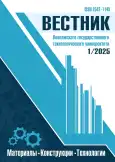Concretes based on portland cement with modified diatomite additives
- Autores: Cherkasov V.D.1, Cherkasov D.V.1, Moskaev S.A.1
-
Afiliações:
- National Research Ogarev Mordovia State University
- Edição: Nº 1 (2025)
- Páginas: 47-53
- Seção: Materials
- URL: https://journal-vniispk.ru/2542-114X/article/view/303835
- DOI: https://doi.org/10.25686/2542-114X.2025.1.47
- EDN: https://elibrary.ru/MUDMZS
- ID: 303835
Citar
Texto integral
Resumo
Introduction. Concrete and reinforced concrete constitute the primary materials in the construction sector. As construction quality standards elevate, it is important to improve the quality of building materials. The quality of concrete is improved by incorporating finely dispersed mineral additives into cement. Their incorporation into cements enhances structural integrity and enables the development of next-generation modified binders. One of such additives is diatomite.
The aim of research is to develop concrete compositions using cement with the addition of modified diatomite.
Materials and methods. Portland cement of class CEM I 32.5 and CEM I 42.5 was used for the research. Diatomite modified with lime (DMI), diatomite modified with hydrochloric acid (DHV), diatomite modified with carbon particles (DMCMTS) served as mineral additives.
The strength of concrete was assessed against GOST 10180-2012 "Concrete. Methods for determining the strength using control samples"
Research outcomes. The research indicated that concretes with modified diatomite enhance the strength classification of concrete to B25 and above.
Conclusions. The incorporation of diatomite-modified cement in concrete production enables a reduction in cement usage by 15 % per cubic metre of the mixture.
Palavras-chave
Sobre autores
V. Cherkasov
National Research Ogarev Mordovia State University
Autor responsável pela correspondência
Email: sergei.pto@mail.ru
Corresponding Member of the RAASN, Doctor of Engineering Sciences, Professor, Head of the Department of Applied Mechanics
Rússia, SaranskD. Cherkasov
National Research Ogarev Mordovia State University
Email: dv-cherkasov@yandex.ru
Candidate of Engineering Sciences, Associate Professor of the Department of Applied Mechanics
Rússia, SaranskS. Moskaev
National Research Ogarev Mordovia State University
Email: sergei.pto@mail.ru
Corresponding Member of the RAASN, Doctor of Engineering Sciences, Professor, Head of the Department of Applied Mechanics
Rússia, SaranskBibliografia
- Agadzhanov V. I. Efficiency of using additives in concrete. Concrete and reinforced concrete – ways of development: scientific works of the 2nd All-Russian (International) conference on concrete and reinforced concrete: in 3 volumes. Moscow: Deepak, 2005. Vol. 3. Pp. 633-635. (In Russ.).
- Eiler R. Chemistry of silica: in 2 volumes. Moscow: Mir, 1982. Vol. 2. 706 p. (In Russ.).
- Bazhenov Yu. M. Concretes of increased durability. Construction materials. 1999;(7/8):21-22. (In Russ.).
- Belykh S. A., Fadeeva A. M. Modified and unmodified finely dispersed industrial waste in concretes and construction mortars. Construction and finishing materials. Standards of the XXI century: XII International seminar of the Asian-Pacific Academy of Materials: in 2 volumes. Novosibirsk: NGASU, 2006. Vol. 2. Pp. 22-24. (In Russ.).
- Benshtein Yu. I., Panina N. S., Ershova L. A. Evaluation of the efficiency of silica additives introduced into high-alkaline cement to prevent internal corrosion of concrete. Journal of Applied Chemistry. 1987;(2):349-355. (In Russ.).
- Erofeev V. T., Dergunova A. V., Batin V. V., Tarakanov O. V. Research of processes of structurization of biocidal composites on the basis of the cement binding. The Privolzhsky Scientific Journal. 2011;(3):64-70. EDN: OIIWPH. (In Russ.).
- Lesnov V. V., Erofeev V. T. Properties of cement carcass composites dispersiely reinforced by fibres on micro- and macro levels. Regional architecture and engineering. 2010;(2):38-43. EDN: MXHSRR. (In Russ.).
- Kalashnikov V. I., Demyanova V. S., Duboshina N. M. Dry building mixes based on local materials. Construction materials. 2000;(5):30-33. EDN: IAJNBN. (In Russ.).
- Komokhov P. G., Shangina N. N. Modified cement concrete, its structure and properties. Cement and its application. 2002;(1):43-46. (In Russ.).
- Losev V. N. Silicas chemically modified with sulfur-containing groups for concentration, separation and determination of noble and non-ferrous metals: abstract diss. ... doctor of technical sciences. Tomsk, 2007. 42 p. (In Russ.).
- Rizvan S. A., Bayer T. A. The role of mineral additives in high-quality cement systems. Concrete and reinforced concrete – ways of development: scientific works of the 2nd All-Russian (International) conference on concrete and reinforced concrete: in 3 volumes. Moscow: Deepak, 2005. Vol. 3. P. 727-732. (In Russ.).
- Tertykh V. A., Belyakova L. A. Chemical reactions involving the surface of silica. Kyiv: Naukova Dumka, 1991. 264 p. (In Russ.).
- Komokhov P. G., Svatovskaya L. B., Shangina N. N., Leykin A. P. Control of properties of cement mixtures by the nature of the filler. News of higher educational institutions. Construction. 1997;(9):51-54. (In Russ.).
- Dvorkin L. I., Solomatov V. I., Vyrov V. N., Chudnovsky S. M. Cement concretes with mineral fillers. Kyiv: Budivelnik, 1991. 135 p. (In Russ.).
Arquivos suplementares








